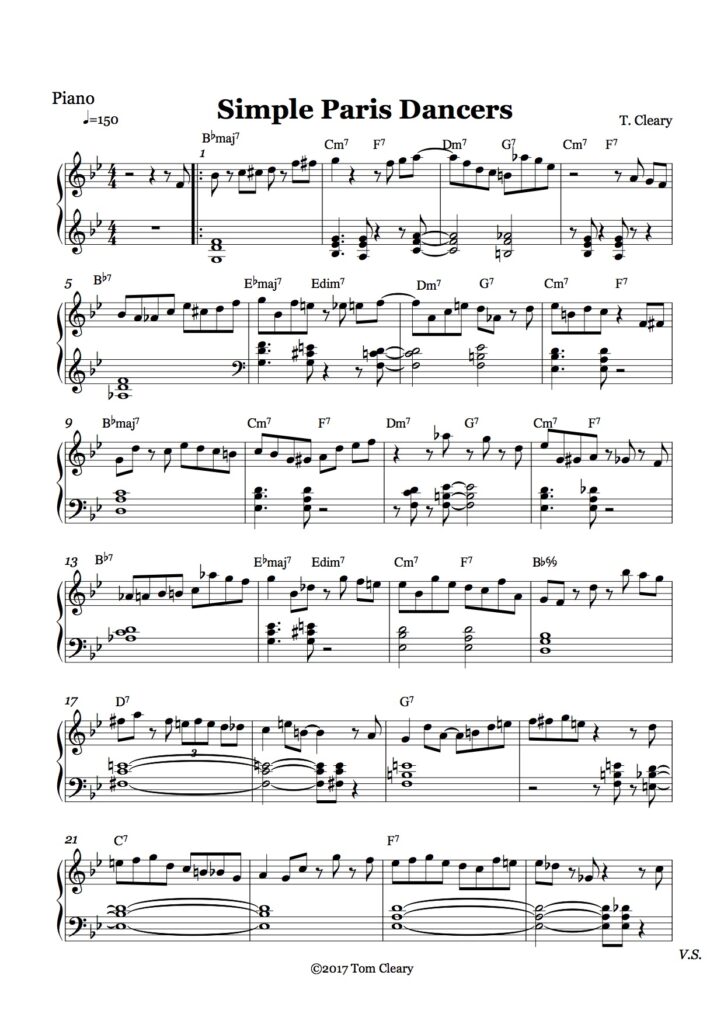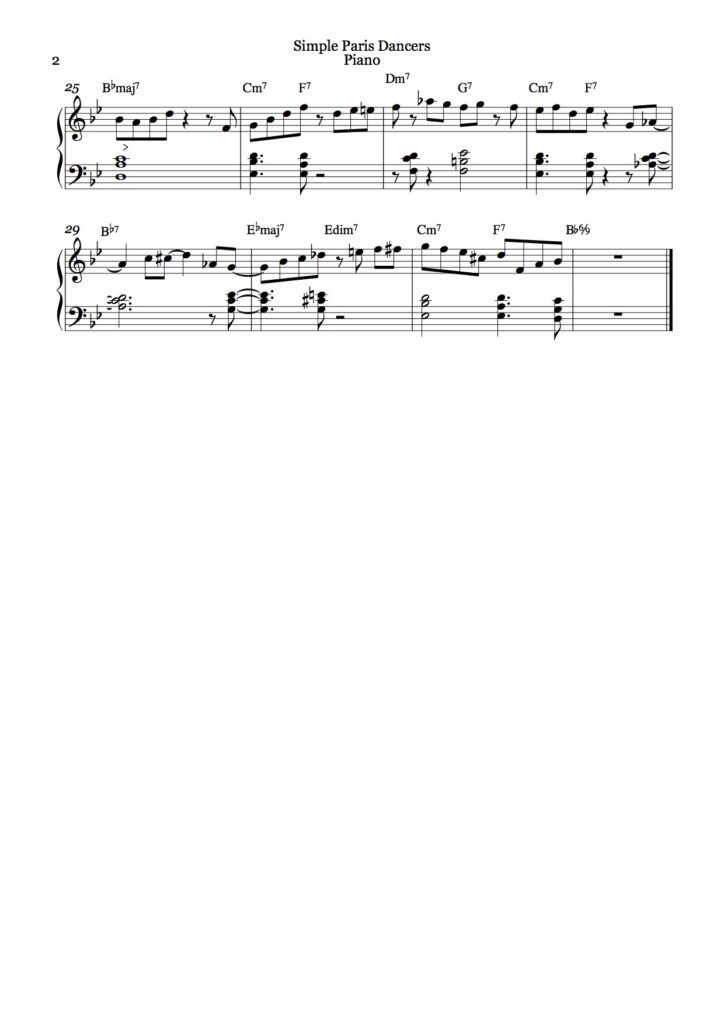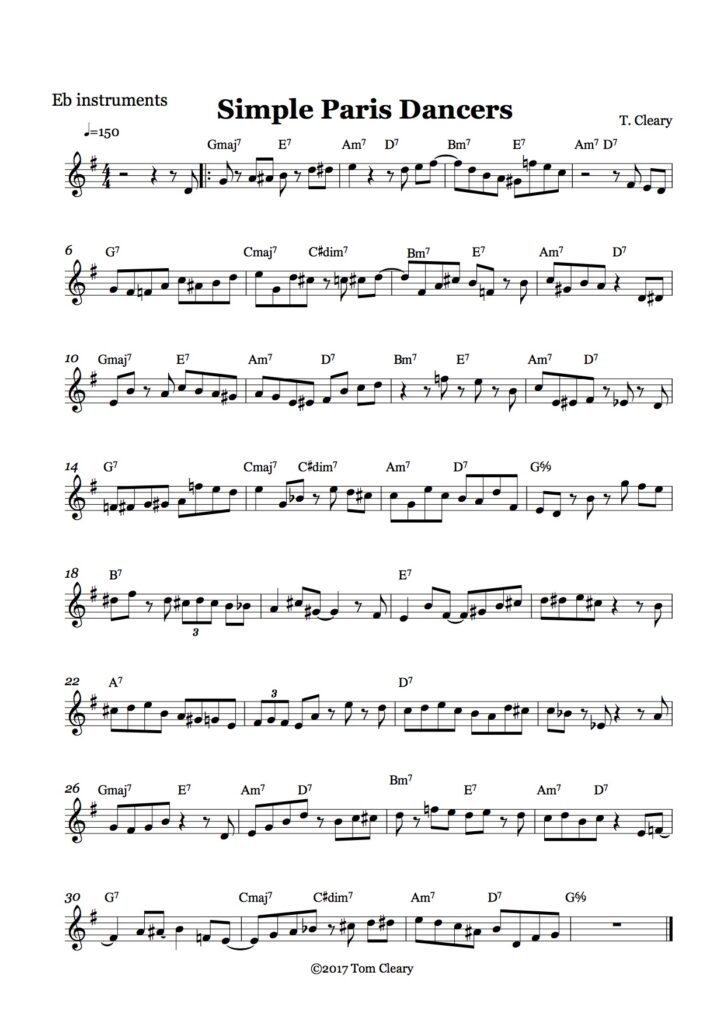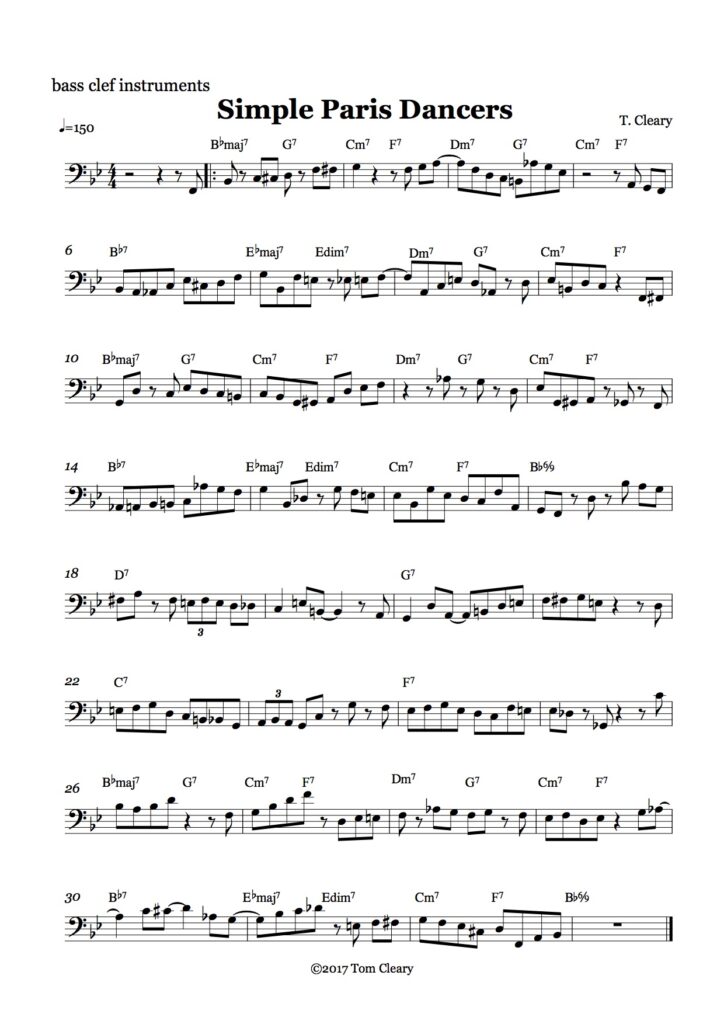‘Simple Paris Dancers’ is a melody line in the bebop style on the ‘Rhythm Changes’ progression. I encourage you to check out the charts below along with a recent recording of the tune by my quartet Birdcode. It is through-composed, in other words, although the chord changes in the first, second and fourth eight-bar sections (which jazz players refer to as the first, second, and last A sections) are quite similar, the melody is different in each section. ‘Rhythm Changes’ refers to the chord changes from the George and Ira Gershwin tune ‘I Got Rhythm’, which has been used by jazz players in many eras as a harmonic basis for original compositions. The changes used in my tune reflect the more harmonically intricate approach that bop player-composers like Charlie Parker (in ‘Anthropology’, ‘Shaw ‘Nuff’ and many other tunes) and Benny Harris (in ‘Crazeology’, aka ‘Bud’s Bubble’, aka ‘Little Benny’) took to the form. This contrasts with the approach of swing-era players who tended to look at the progression as a series of larger harmonic regions; one example of this is Lester Young’s solo on ‘Lester Leaps In’.
My tune is based on the bop rhythm changes outline. I am posting only the recording of the outline and not notating it in keeping with Barry Harris’ practice of teaching jazz theory concepts by ear and without staff notation. (We do assemble the line slowly in class and use a kind of rap to aid with memorization of it.) In order to give a complete performance of ‘Simple Paris Dancers’ or any other rhythm changes tune (in other words, a performance that includes an improvised solo), it is helpful to practice some sort of melodic outline of the progression using scales (as in the pre-bop rhythm changes outline we study), or arpeggios, or a combination of both as in the bop rhythm changes outline. Practicing the outline should help with giving you an understanding of the melodic and harmonic context of rhythm changes, both conceptually and in terms of physical memory. For pianists, the scale outline helps map out the B-flat major topography of the progression. Although the scale outline is fairly repetitive, it is intended to prepare you for improvising on rhythm changes in the same way that running laps around the perimeter of a playing field warms you up to play a game. It familiarizes you with the landscape in which you will be playing (largely B flat major, but also the 7th scales in D, G, C and F) and the general pace at which you need to move through the landscape (eighth notes). It also models the 7th chord harmony of the progression through its ‘7 up and down’ patterns which emphasize the structure of the chords by stopping short of the octave and the concept of leaving space in solos with the rests at the end of each scale.
The title of the tune refers to three of the tune’s melodic sources. I began composing this tune as an eight-bar example for my improvisation class to show how the Shaker hymn tune ‘Simple Gifts’ has the same basic harmonic and phrase structure as ‘I Got Rhythm’ and can be converted into a jazz line by adding swing eighth notes, the bop rhythmic approach of emphasizing upbeats as well as beginning and ending most phrases on upbeats (two instances of what Hal Galper calls ‘forward motion’ in a melodic line), and bop-style chromaticism (or what Barry Harris calls ‘half-steps’.) I’ve revised the tune a lot since it started life as a class example, but the remnants from ‘Simple Gifts’ of its bar 1 (‘tis a gift to be simple, tis a gift to be free’) and bar 9 (‘when true simplicity is gained’) can still be seen in the corresponding measures of my tune. ‘Paris’ refers a part of my tune where a pattern from John Lewis’ ‘Afternoon in Paris’ makes an appearance, and ‘Dancers’ refers to a pattern from Duke Elllington and Billy Strayhorn’s ‘Dancers In Love’. Both of those patterns are also discussed in my post Give It Up For The Root (Position Pattern)s! It also uses in m. 3 what pianist and educator Barry Harris calls the ‘turnaround lick’ (which can be found in the tune Reets and I by the trumpeter Benny Harris); in m. 10 it uses what Barry Harris calls the ‘4 lick’ (which can also be found at the end of Charlie Parker’s ‘Shaw Nuff’ solo), and throughout the bridge it uses the half step between the root and the 7th of the ‘seventh scale’ (a.k.a. mixolydian scale.)
A live duo recording of ‘Simple Paris Dancers’ that I made with mandolinist Jamie Masefield can be heard here. I welcome comments of all kinds, including your favorite tunes and solos on the rhythm changes progression (tunes in the Real Book that use it include ‘Anthropology’, ‘Cottontail’ and ‘Dexterity’, but rhythm changes tunes have also been recorded by artists from Nat King Cole to Phish) or thoughts on practicing scale outlines. I’d also consider posting recordings of ‘Simple Paris Dancers’ being performed solo or with accompaniment of any kind; you’re encouraged to include a chorus of your own solo as well.




American Past-times: Jazz and Sports
To refer back to a conversation from class, I never have been much of a fan of baseball. I grew up playing basketball with my Dad and brother, so perhaps because of nostalgia I’m partially biased, but I have never been a great fan of the structured nature of baseball. It’s incredibly turn oriented, and there is a great deal of time spent waiting for the action the begin. The hitter reaches the mound, other players wait, then the ball is tossed. If it’s struck, the action begins and everyone breaks off in a mad dash, then after that everyone begins waiting again, or the teams trade roles and so on. I always found that approach to athletics to be tedious, and too turn oriented. And most importantly of all, I found it boring to watch. But I have always enjoyed more fluid sports, like soccer and basketball, where the energy is constant.
To relate this to jazz, one could relate bebop to baseball. It’s a very structured music, with multiple harmonic changes. The changes could be seen as the bases, and the one up to bat assuming the same role as a soloist. When their times comes, they dash off, trying to make the changes through the field, like being able to play to the chords of a tune. To take this one step further, maybe basketball and soccer are closer to modal jazz? In these sports, there are only two goals, and no basses, and the game itself is much more chaotic. It’s similar to how modal jazz normally utilizes only two or three chords in a given tune. One could even argue that, with less restrictions, this gives the soloist more liberty in their soloing, like how in basketball/soccer, the player has more space and more options to reach their goal. To take this even further, in free jazz, there is no game at all, completely removing the limitations of structure. Instead, the closest athletic comparison might just be running around in a field with your friends with no given objective besides enjoying the sensation of being in motion.